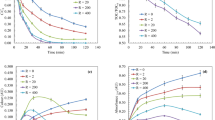Abstract
The combined photolysis-hydrolysis rate of chlorpyrifos in water at 25†C followed simple first-order kinetics at 9 × 10−7M concentration. In buffered, distilled water at pH 5.0, 6.9, and 8.0, the half-life was 11.0, 12.2, and 7.8 days, respectively. The half-life of the isolated photolysis reaction was 13.9, 21.7 and 13.1 days, respectively. Qualitatively, the products of the combined photolysis-hydrolysis reactions with chlorpyrifos wereO-ethylO-(3,5,6-trichloro-2-pyridyl)-phosphorothioate, 3,5,6-trichloro-2-pyridinol, and five radioactive unknowns, one of which was thought to contain H14CO −3 .
Loss rates of chlorpyrifos due to photodecomposition on and volatilization from an inert surface at 25†C were best represented by first-order processes. The half-life for disappearance of chlorpyrifos was 3.2 and 0.3 days, respectively. The results reported herein suggest that on those occasions when chlorpyrifos shows reduced efficacy in the field, volatility loss may be the primary cause.
The rates of photolysis and hydrolysis reactions are sufficiently fast that the compound will not persist in bodies of water, nor will the compound present any problems relative to field reentry safety intervals.
Similar content being viewed by others
References
Bruno, G. A., and J. E. Christian: Determination of carbon-14 in aqueous bicarbonate solutions by liquid scintillation techniques. Application to biological fluids. Anal. Chem.33, 1216 (1961).
Christian, G. D., and W. C. Purdy: The residual current in ortho-phosphate medium. J. Electroanal. Chem.3, 363 (1962).
Collier, B. L., and C. D. Dieter: DURSBAN® ... A new insecticide for chinch bug and sod webworm control in St. Augustine grass. DOWN TO EARTH®21(3), 3, (1965).
Crosby, D. G., A. S. Wong, J. R. Plimmer, and E. A. Woolson: Photodecomposition of chlorinated dibenzo-p-dioxins. Science173, 748 (1971).
Dobbs, A. J., and C. Grant: Pesticide volatilization rates: A new measurement of the vapor pressure of pentachlorophenol at room temperature. Pestic. Sci.11, 29 (1980).
George, M. V., and V. Bhat: Photooxygenations of nitrogen heterocycles. Chem. Rev.79, 447 (1979).
Gray, H. E.: DURSBAN®: A new organo-phosphorus insecticide. DOWN TO EARTH21(3), 1 (1965).
Holloway, P. J., and E. A. Baker: The cuticles of some angiosperm leaves and fruits. Ann. Appl. Biol.66, 145 (1970).
Kenaga, E. E., W. K. Whitney, J. L. Hardy, and A. E. Doty: Laboratory tests with DURSBAN® insecticide. J. Econ. Entomol.58, 1043 (1965).
Meikle, R. W.: The hydrolysis and photolysis rates of nitrapyrin in dilute aqueous solution. Arch. Environ. Contam. Toxicol.7, 149 (1978).
Meikle, R. W. and C. R. Youngson: The hydrolysis rate of chlorpyrifos,O,O-diethylO-(3,5,6-trichloro-2-pyridyl) phosphorothioate, and its dimethyl analog, chlorpyrifosmethyl, in dilute aqueous solution. Arch. Environ. Contam. Toxicol.7, 13 (1978).
Muelder, W. W., and M. N. Wass: A semimicro preparation ofO,O-diethylO-(3,5,6-trichloro-2-pyridyl-2,6-14C2) phosphorothioate. J. Agr. Food Chem.15, 508, (1967).
Smith, G. N.: Ultraviolet light decomposition studies with DURSBAN® and 3,5,6-trichloro-2-pyridinol. J. Econ. Entomol.61, 793 (1968).
Tinsley, I. J.: Chemical concepts in pollutant behavior, p 45. New York: Wiley-Interscience (1979).
Ware, G. W., B. Estesen, and N. A. Buck: Dislodgeable insecticide residues on cotton (1976). Bull. Environ. Contam. Toxicol.20, 24 (1978).
Author information
Authors and Affiliations
Rights and permissions
About this article
Cite this article
Meikle, R.W., Kurihara, N.H. & DeVries, D.H. Chlorpyrifos: The photodecomposition rates in dilute aqueous solution and on a surface, and the volatilization rate from a surface. Arch. Environ. Contam. Toxicol. 12, 189–193 (1983). https://doi.org/10.1007/BF01059580
Received:
Accepted:
Issue Date:
DOI: https://doi.org/10.1007/BF01059580




